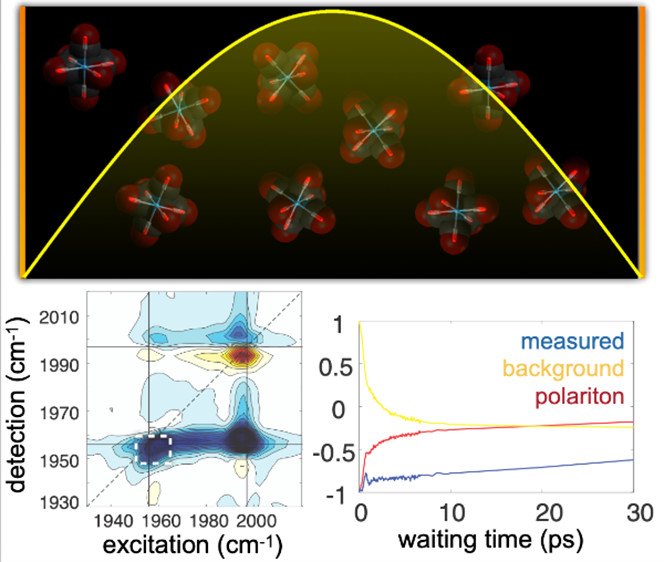Chemistry in Optical Cavities
Solutions of many molecules (10-100 mM) are contained in a microcavity formed by two nearly 100% reflecting mirrors. When a cavity resonance is tuned to match a molecular transition (in this illustration a carbonyl vibration), it is possible to establish strong coupling, leading to two new “polariton” states split in energy proportionally to the coupling.
Molecular polaritonics
Experimental evidence has shown that some chemical reactions can be altered—either the kinetics or thermodynamic equilibrium—by strong coupling to resonant optical cavities. This new breakthrough represents a dramatic change in how we can imagine controlling chemistry using remote macroscopic interactions.
Longitudinal mode field distribution causes the molecule-cavity coupling to depend on position in the cavity. This effect leads to weakly coupled molecules located near the mirrors and any nodes of the cavity. These produce a background 2D-IR signal that is results from the ordinary molecules, but spectrally filtered by the polariton transmission. We figured out how to remove this background artifact in cavity 2D-IR measurements.
One way of viewing strong coupling is as an additional degree of freedom in the free energy landscape. Through strong coupling to molecular degrees of freedom, the joint system’s free energy profile can be manipulated by the resonant optical field. The key idea is that it is the free energy not simply the potential energy that is modified, meaning that emergent properties such as entropy have the chance to play an outsized role due to the very low entropy of the highly delocalized, collective polaritonic state.
Research in this area in our group is very new, but we are rapidly progressing. We will update this topic area as we get closer to publishing our new results, so stay tuned!
Isolating the Polartonic Response
There are two sources of nonlinear optical signals that complicate measuring the true polaritonic response. First, due to the requirement for many molecules to achieve strong coupling, there are inherently N-1 so-called dark state molecules (where N is the number of molecules in the cavity). Additionally, in real cavities, the field mode distribution is not uniform (it must at least go to zero at the mirror surfaces), so molecules in the low-field regions have weaker coupling to the optical mode. These two facts conspire to produce a background 2D-IR signal that is filtered by the linear transmission of the polariton cavity. We recently have identified this background, and have shown how to remove it by taking advantage of the remarkable aspect of polaritons that they lack inhomogeneous broadening. Read about our work here.


